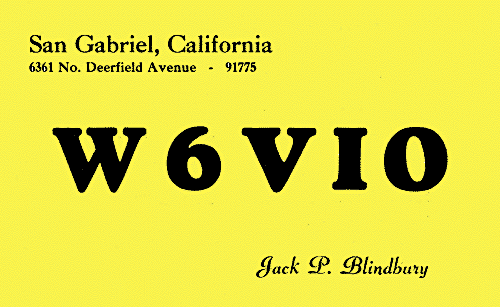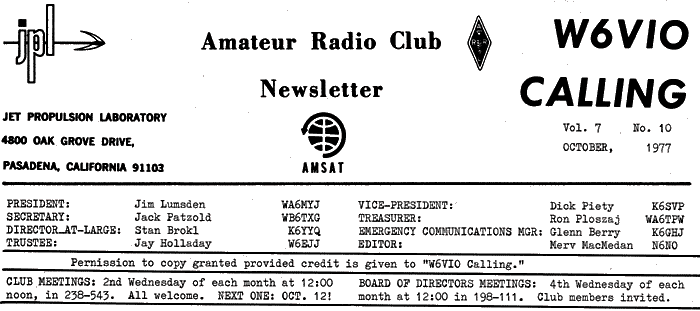
AND THE WINNER
IS ...
The results of the ARRL election for Section Communications Manager
(SCM) for the Los Angeles Section are in:
Stan Brokl, K6YYQ 689
Perry Masterson, W6RHS 598
The JPL ARC now is blessed with having provided two ARRL officials for you to harass! [Ed. note - the other is, of course, the Southwestern Division Vice Director, Jay Holladay, W6EJJ.]
Perry Masterson
has agreed to help me by accepting an appointment as Assistant
SCM. This appointment will be effective with the start of my
term, October 1. I'll be expecting lots of help and advice from
all the JPLARC members over the next two years!
73, Stan K6YYQ
MEET THE REAL W6VIO
By Bob Biswell,
W6MZR, and Merv MacMedan, N6NO
With the increased interest in researching one's ancestry, spurred
by the recent book and movie, Roots, we thought it was high time
our club's roots were chronicled in these pages. The investigative
reporter team of Biswell and MacMedan discovered that W6VIO was
once a real, live person. This is the story of that person.
During the mid-50's, when Bob Biswell was in High School, his electronics teacher nurtured his interest in amateur radio. After Bob received his license, he mentioned it to his ex-scout leader, a few doors away, Surprisingly, this gentleman knew much about the hobby and helped Bob along. Bob had become W6MZR; his neighbor, Jack Blindbury, became W6VIO. Actually, Jack had been a ham back in the 20's, holding 2-letter calls, but had drifted away from the hobby during the war years of the 40's when ham radio was totally shut down. He became relicensed as W6VIO just about the same time Bob was getting started.
Jack lived in San Gabriel. Back in the 50's. Jack became known to another JPLARC member, Walt Baumgartner, W6WLH, when he visited Walt at North American Aviation in Downey in his job as a sales engineer for a local microwave products company.
Jack first came to JPL in the early 60's. He ran the Lab's electronic stores operation, and was particularly instrumental in rejuvenating the JPL Radio Society. He became its President, and the club went on the air with the call WA6DYJ.
During this period, Jack was also very active from his home station, W6VIO. He was a humble, generous person, always willing to accommodate requests for help, such as phone patches. He was on the air regularly with a "network" of friends, such as W6MMB, K7TWD, W7EFS, and W6DQE. He handled so many phone patches with a repair ship in the Pacific, the USS Frontier, that the crew awarded him a well-deserved plaque in recognition of his efforts.
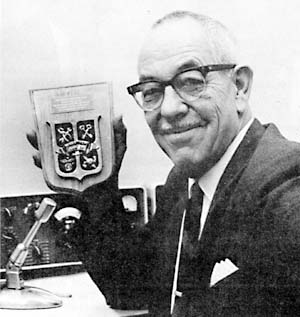
Jack Blindbury, W6VIO, with award
from USS Frontier. [Photo
courtesy of Bob Blindbury.]
Most of Jack's on-the-air activities took place on 20 meters. In the earlier period of W6VIO, he had a classic KW of AM, driven by a Meissner Signal Shifter and a HRO-5 receiver. Later, this station was replaced with a Heathkit SB-line receiver, exciter, and KW linear amplifier. Radiation took place from a triband TH6DX beam on a 55-foot telescoping tower. The shack itself was located in his garage.
Jack left the Lab in the mid-60's to take a position with Space General. Shortly after the change, he went to his doctor because he was feeling badly. The diagnosis: Cancer. The next 8 or 9 months were very difficult for Jack. He remained on the air for as long as he could, making the daily trip to his shack in the garage to meet his friends on the regular schedule. But finally he became too weak to leave the house. It was his saddest moment when he called Walt, W6WLH, and asked him to go on the air for him to tell his buddies that he couldn't make it anymore. Jack was in his early sixties when he passed away in December, 1968.
As if that tragedy was not enough for his family, his XYL passed away just 4 months later, leaving their two children, Joan and Bob, with many difficulties to solve. Since neither were hams, they tried halfheartedly and sadly, to dispose of that garage-full of strange equipment. With a helping hand from Bob Biswell, a difficult chore was accomplished. Bob bought the entire station, which remains today intact at his home in La Crescenta.
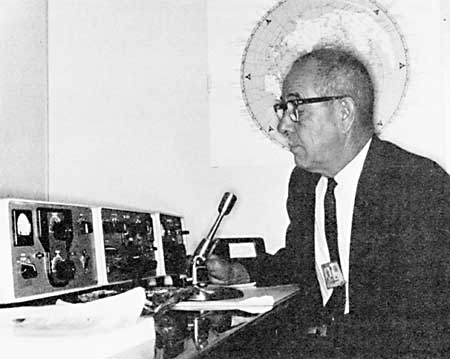
Jack Blindbury, W6VIO, at Space General.
[Photo courtesy of Bob Blindbury.]
One day, Bob was listening to 20 m SSB and heard a vaguely familiar call, K7TWD. He broke into the group to ask if any of them knew Jack Blindbury, W6VIO. "Yes," was the answer, "but he died some time ago." Bob responded that he had known Jack and the group might be interested to know that they were hearing Jack's rig again, but this time at W6MZR. They were all glad that Jack's rig had fallen into the hands of a good friend of his.
After Jack and his enthusiasm for amateur radio both left JPL, the Club went through a very trying period that effectively put it into suspended animation. Then, with the establishment of the NASA Emergency Radio Network, a new wave of enthusiasm began. In the process of rebuilding the club in 1968-69, Walt Ross, W6VPN, who also had known Jack, suggested that instead of renewing the club's old call, WA6DKJ, it would be fitting to request that the FCC issue W6VIO to the club under their "In Memoriam" rule.
And so, on October 3, 1969, with Jay Holladay as the Club's Trustee, "W6VIO" was issued to the JPL Amateur Radio Club, in whose hands it remains today as a fine memorial to its former President, Jack Blindbury.
Jack's W6VIO QSL Card (Black letters on yellow card stock) [Courtesy of Bob Blindbury.]
[Ed. note: While we followed every lead that we could, we believe the story of Jack Blindbury is incomplete. If anyone can help us with more details of his on-the-air activities and his earlier calls, we would be most grateful. Please contact Bob Biswell, X 2303, or Merv MacMedan, X7264.]
W6 VOYAGER - IN - OUTERSPACE By Rich Ward, N6BF
The Voyager II Launch Commemorative, August 20-31, 1977, was met with eager response by the amateur community, in spite of the lack of a special event call. Pileups reminiscent of the N6V activity were not uncommon, and while the number of QSO's was not enormous (approximately 400,) the many questions asked and enthusiasm generated made it a worthwhile undertaking for the club. All the old slow scan bunch was there, taping pictures we sent of the launch and spacecraft. Needless to say, they are already anxiously awaiting the encounter commemoratives. Most QSO's took place on 15 and 20 meter SSB with some contacts of 220 MHz and 2 meter FM. We even had four RTTY QSO's on 20.
I would like to express appreciation on behalf of the club to Jim Lumsden, WA6MYJ, whose commemorative experience and sage advice saved me a great deal of time; to Jack Patzold, WB6TXG, who was a great help in preparing the station for the commemorative and who also operated; to Norm Chalfin, K6PGX, who arranged the publicity in the amateur radio journals; to Stan Hench, WB6JMP, for designing the QSL card; and to Steve Brown, WA6LAO, Stan Brokl, K6YYQ, Stan Sander, N6MP, and Nash Williams, W6HCD, for operating support.
W6QSL BUREAU
The JPLARC is now responsible for sorting QSL cards for three letters in the W6 QSL Bureau. Bob Brodkin, WA6TBH is our most recent volunteer; George Williamson, K6YGN, who left the Lab last year continues the task from home; and Cliff Moore, K6KII continues to do an outstanding job. The Bureau Manager, Archie Willis, W6LPJ, says that our club's work has had no complaints for over the past 2 years. Keep up the good work! 73, Stan - K6YYQ.
SOLAR POWERED AMATEUR RADIO STATION
The JPLARC, W6VIO, will operate a Solar Powered station at "Energy Fair '77" to be held November 3rd through 6th at the Anaheim Convention Center, across the street from Disneyland. W6VIO will use all solid state equipment. On the HF bands, the club will operate two SSB/CW transceivers (FT101 and Triton IV) at input power levels of approximately 100 watts. In addition there will be activity on the VHF bands at input powers of 5-20 watts.
The main power source for the station will be the Sun (operating through a 200 watt array of silicon solar cells, of course.) The solar cells will be used to keep a 12-volt storage battery charged.
The antennas for the operation of the station will be mounted atop a walkway on the roof of the Convention Center. It is anticipated that the station will operate on a 50-60% transmitting duty cycle so that transmissions will be possible even with limited periods of overcast and during some of the evening hours.
Last year's Energy Fair '76, was attended by over 25,000 people during its two-day run at the Los Angeles Convention Center. It is anticipated this year that the fair will attract as many as 50,000.
Gil Yanow, K6TOS,
is chairman of the project, with
Stan Brokl, K6YYQ Station Manager, Norm Chalfin,
K6PGX Publicity, and Merv MacMedan, N6NO traffic
manager. [Tnx K6TOS.]
SUNFIRE COMMUNICATION ESTABLISHED WITH PITCAIRN ISL.
The club station, W6VIO, provided the means for getting a progress report on the Sunfire Project to Tom Christian, VR6TC, on Pitcairn Island, the last week of September. The Sunfire Project is to provide electricity on Pitcairn, using a Rankine cycle steam driven alternator, the steam being generated in a large solar collector, which is now taking shape in the lower Arroyo parking lot here at the Lab.
The system is being constructed entirely by the high school student members of Space Explorer Post 509, sponsored by JPL, with Howard Broyles of Section 346 as adult advisor on the project. The project is funded entirely by student fund-raising activities and voluntary contributions.
Mark White, student
Project Coordinator for Post 509, and Howard were able to talk
direct with Tom Christian on 15 meters SSB regarding progress,
latest design specifications, and some problems in shipping and
installation of the system on Pitcairn, which should take place
sometime next year. For more information on Sunfire, see the
current display in the Library, and Lab-Oratory, issue 1976-4.
[Tnx
K6GPK]
FLIGHT TEST OF AMSAT/JAMSAT SATELLITE TRANSPONDER
The Radio Amateur
Satellite Corporation (AMSAT) has obtained the cooperation of
a number of amateur radio clubs up and down the state of California
in flying the AMSAT-OSCAR-D 2-meter-to-70-centimeter (146 to
435 MHz) amateur radio satellite transponder for a test to provide
amateurs throughout the state An opportunity to test their gear
and to familiarize themselves with the techniques and procedures
to be used in operating the transponder during its orbital phase
as AMSAT-OSCAR-8, Mode J. The flight will take place December
3, 1977. An aircraft containing the transponder will fly a course
starting from Van
Nuys Airport, near Los Angeles, to San Diego, Santa Barbara,
San Francisco, Stockton, Fresno, Bakersfield, and back to Van
Nuys.
A great many operators participated in similar earlier test flights, learning the ropes, so to speak, about operating through an amateur satellite transponder under closely similar conditions to those which would occur in orbit.
Activity through the transponder is encouraged during the December 3rd flight, and a commemorative QSL will be sent to all amateurs who send in a report of stations worked or heard. The aircraft call in flight will be AMSAT's, WA3NDS. During the flight, a liaison net will be maintained about 7230 kHz, using the call W6VIO.
The test flight is co-sponsored by the amateur radio clubs of Jet Propulsion Laboratory, Hughes, TRW, and Project Oscar, as well as several other California amateur organizations.
One major purpose of the flight is to assist radio amateurs to adjust their equipment for operation on the new satellite frequencies assigned to amateurs above 435 MHz. A secondary purpose is to determine the mutual interference potential between the satellite users and amateur fast-scan TV enthusiasts operating above 435 MHz. Launch of the A-0-D amateur radio communications satellite is scheduled for February 17, 1978.
Reports should
be sent to Skip Reymann, W6PAJ, at P.O.
Box 374, San Dimas, Calif. 91773. [Tnx K6PGX]
[Ed. Note: Lead appointments for the test flight on December 3, with a short shakedown flight on November 5, include the following JPLARC members:
Skip Reymann, W6PAJ, Project Manager
Booth Hartley, N6BH,Pilot
Maurice Piroumian WA60PB,Co-pilot
Dick Ulrich, K6KCY, Flight Engineer]
EARL BURDICK MOVES EAST
Earl Burdick,
WA6BDN, is all squared away in a new job
with Sperry Rand in Utah. His address at home is 1619
East Wilson, Salt Lake City, Utah 84105. Work phone is
801-328-8066, Ext. 5205. There are 6 hams in the group
who will be looking forward to working W6VIO. Hope we
can keep in touch, Earl! [Tnx W6HCD]
CALIFORNIA PROFESSIONAL ENGINEERS CRAM COURSE
Electrical Engineering Fundamentals Review is a course to be given starting October 6 by instructor William E. Murray. The total cost, as part of an adult education program, is $8.25. Classes will be held Thursdays, 6-9pm in room 572, L.A. Dept. of Water and Power Bldg., 111 N. Hope St., L.A. (Free guarded parking.) Preparation is for the California State Professional Electrical Engineering exam. Topics will include electronics, servo systems, economic analysis, power, machinery, fault analysis, networks, etc. For more information, call 213-593-1656 or 714-838-7556 evenings. [Tnx IEEE Bulletin, Los Angeles.]
OPERATORS NEEDED FOR BAJA 1000
The Baja Amateur Radio Racing Association (BARRA) needs operators and equipment to provide communications for the Baja 1000 Km 1977 race, to be held on Nov. 10, 11, and 12, 1977. Pre-race coordination will be held starting October 9 and each Sunday evening thereafter until the race at 1830 local time on 3903 kHz. If you can help, contact Gordon Jewell, WA6GQF, 7261 Bel Air Dr., Corona, Ca. 91720; tel. 714-737-7261. [Tnx W6HCD]
ARRL NOTES By Jay Holladay, W6EJJ
W6KW Status: As you may have heard, our ARRL Southwestern Division Director John Griggs, W6KW, suffered a stroke on September 10. John is now in the rehabilitation unit at Northridge Hospital, undergoing extensive therapy. He is recovering, but it will be some time before he is fully back in action. John appreciates the many cards he has received and the visits from old friends. The hospital's address is 18300 Roscoe Blvd., Northridge, Calif. 91324.
Repeater Deregulation: On September 21, the FCC acted on Docket 21033 dealing with Repeater simplification. There is to be an immediate freeze on the filing of applications for new repeater, auxiliary link, and control station licenses. Also, effective November 4, 1977:
a) Distinct licenses for repeaters, auxiliary link, and control stations will be eliminated. These modes of operation will become privileges inherent in all individual primary licenses and club station licenses. This means that distinctive "WR" prefixes for repeaters are being abolished. However, present repeater, auxiliary link, and control station licenses remain in effect until expiration, at which time they will not be renewable. Also, applications for repeater station licenses now on file will be dismissed without action.
b) Portable and mobile operation of auxiliary link stations has been approved.
c) In addition to the present repeater sub-bands, the following frequencies have been made available for repeater use: 144.5 - 145.5 MHz, 220 MHz and up (except 435-438 MHz.)
d) Technician class licensees have been granted additional privileges at 144.5 - 145 MHz, so that they may use the newly created repeater sub-band on two meters.
e) The identification interval for repeaters has been extended to at least once each 10 minutes.
f) Stations operating in the repeater mode shall identify either in phone by adding the word 'repeater' after the primary call sign, or by CW by following the primary call with "/RPT." Stations operating in the auxiliary link mode (or control mode - the control function has been combined with that of aux link) shall identify either by phone by appending the word "auxiliary" after the primary call, or by cw by including "AUX" after the primary call.
g) Transmissions from open access, automatically controlled repeaters need no longer be monitored or recorded.
There was no action taken on the establishment of priorities for frequency use, on modifications of the present effective radiated power versus height above average terrain requirements, or in the elimination of the requirement that a record of third party traffic must be maintained in the log of a repeater station, or of a station operating in the repeater mode.
Band Plan for new 2-meter sub-band: As soon as the FCC announced its decision on the new 144.5-145.5 repeater sub-band, ARRL was ready with a band plan that has been endorsed by nearly all the coordinating groups. Briefly, here is the plan:
All inputs low,
outputs high. (A quick check shows that the least harmful intermods
occur to weak signal and Oscar work above the new band segment.)
A total of 20 channels, 20kHz spacing, no splits. The first channel
starts at 144.51, the last at 144.89. Input/ output spacing,
600 kHz. The section from 144.9 to
145.1 (200 kHz) is reserved for non-channelized communications,
weak signal, SSB, etc. More details will appear in the FM &
Repeater News column of the November issue of QST.
WR6APS AT JPL
New Calls on the Club's repeater (222-44/224.04):
K6SUE - Paul
WB6UIA - Pete
For those interested in making the Midland/Clegg 220 rig modification reported in the June issue of W6VIO Calling, Walt Diem, WA6PEA now has a step-by-step instruction sheet along with a board layout diagram showing the proper locations. Copies may be obtained on request to Walt, X3186. The modification referred to deals with the installation of an 18 MHz trap in the receiver first oscillator to eliminate spurious responses in the receiver.
BOARD MEETING HIGHLIGHTS
Here are your editor's unofficial notes from the Board Meeting of September 28. Present: Patzold, Brokl, Holladay, Ploszaj, Berry (all wielding votes) plus non-voting attendees Ward, Yanow, Chalfin and MacMedan.
Minutes of the July meeting were approved as read by Patzold. While no quorum was present at the August meeting, a telephone poll taken after the meeting by Patzold resulted in approval by the club to support the OSCAR-8 aircraft test flight as requested by Skip Reymann, W6PAJ.
Patzold introduced a motion to share some of the profits of our recent Hot Dog Sale at the JPL Picnic with the Goldstone Amateur Radio Club. It was pointed out that GARC members helped substantially at the picnic and in addition provided much support for our recent Field Day activity. A sum of $75 was agreed upon and approved; Patzold will draft a letter and send the funds.
Ploszaj gave the Treasurer's report, then submitted two off lab members applications for approval: Herbert Hoover III, W6ZH, and Dale Irvine, WB6JQY. Both were approved.
Yanow reported on plans for the Energy Fair in which W6VIO will participate (see article on page 3.)
Holladay presented a report from Skip Reymann on progress being made with the OSCAR-8 aircraft test flight scheduled for December 3. (see article on p. 3)
FOR SALE
Two-meter Mobile Antenna - Motorola TAD 6112A 17 wave antenna, rooftop (or trunk) mount with cable, plus Antenna Specialists ASP-553 5/8-wave antenna, compatible with Motorola mount. Both brand new in unopened cartons. $25.00 takes both. Jay, W6EJJ, X4443, or 790-1725, or via WR6APS.
FOR SALE
Clegg FM-27 late model 2-meter transceiver, synthesized 146-148 MHz with power supply. 2 years old, good condition. $250. Von Roos, X4790 or home, 255-0274.
FOR SALE
Complete Station. Drake TR3, RV3 remote VFO and speaker, AC power supply, homebrew DC supply, mobile mount and spare set of final tubes with all interconnecting cables. Asking price for everything $350. Gil Yanow, K6TOS, X6713 or 2402; home 714-595-4102.
CONGRATULATIONS ...
...to Steve Brown, WA6LAD, for his Extra on Aug. 31.
...to Ralph West, N6YM, for shedding his old WB6YMF.
...to Jim Lumsden, WA6KYJ, for adding two harmonic YLs to his family instead of attending the Board Meeting
PRESIDENT'S MESSAGE
Hi. Glad to be back. Many thanks to all for carrying on during my 4 month sojourn at Cape Canaveral for the Voyager launches.
Congratulations to Merv MacMedan for a really award winning job as W6VIO CALLING editor. This newsletter won first place in its class in the Amateur Radio News Service Publications Contest. It takes a lot of effort to be consistently good.

Certificate received by the club attesting that W6VIO CALLING is No. 1!
My apologies to the Board for missing the September Board Meeting, even though I was back in town. We have just added 4 and 5 year old daughters to our family. It takes a bit of adjustment; for example, my station has been adjusted right out of the shack and into the living room!
Manpower requirements for this fall period continue to be very high and the commitments by the club are important to both our club and amateur radio. You are part of it all - Let's volunteer!
73, Jim Lumsden, WA6MYJ
X 6726 (for a while.)
2 METERS REVISITED By S. S. Brokl, K6YYQ
A couple of weeks ago, I broke down and bought a new IC-22S two-meter transceiver. I found it an extremely good buy. Also, I found errors in the programming chart supplied with the instruction book. While this rig is synthesized, it is still limited to 22 pre-programmed channels. These must be selected beforehand, and then diodes soldered into a matrix to provide the desired frequencies. How nice it would be if I could somehow bring all those diode hookups outside the case to a panel where I could select them manually and cover any two-meter channel!
I found that it is extremely easy to attach a 9-conductor flat ribbon cable to one of the channel selections and build a simple box with only eight switches and eight diodes which will allow the user to program up any frequency from 145-350 to 147.990 in 15-kHz increments. The box schematic is shown in Fig. 1.

Fig. 1: IC-22S Programming Box
Attached is a computer-generated programming chart which gives
additional frequencies available and has no errors (I hope!).
In this truth table, 11111 indicates a closed switch, while "0"
means open; the Most significant bit is at the left.
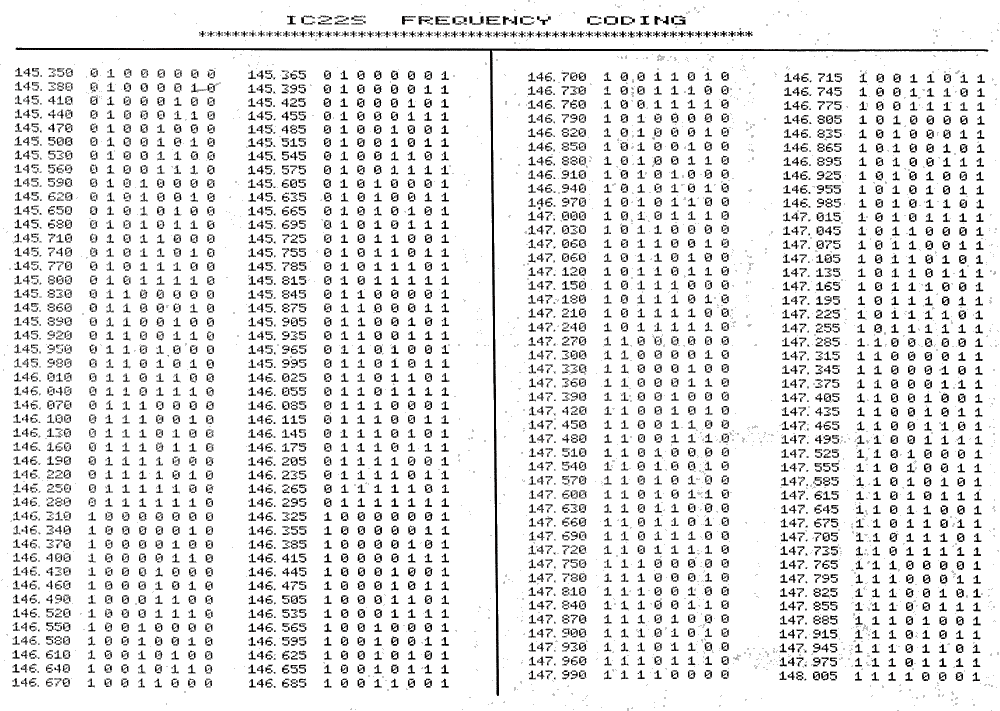
While this may not be the best way to do it, it is fast and easy. I had the switch box built and installed within an hour. It works!
Jet Propulsion Laboratory Amateur Radio Club
Attn: Bill Wood, Editor,
Mail Stop DSCC-33
4800 Oak Grove Drive
Pasadena, CA 91109-8099
